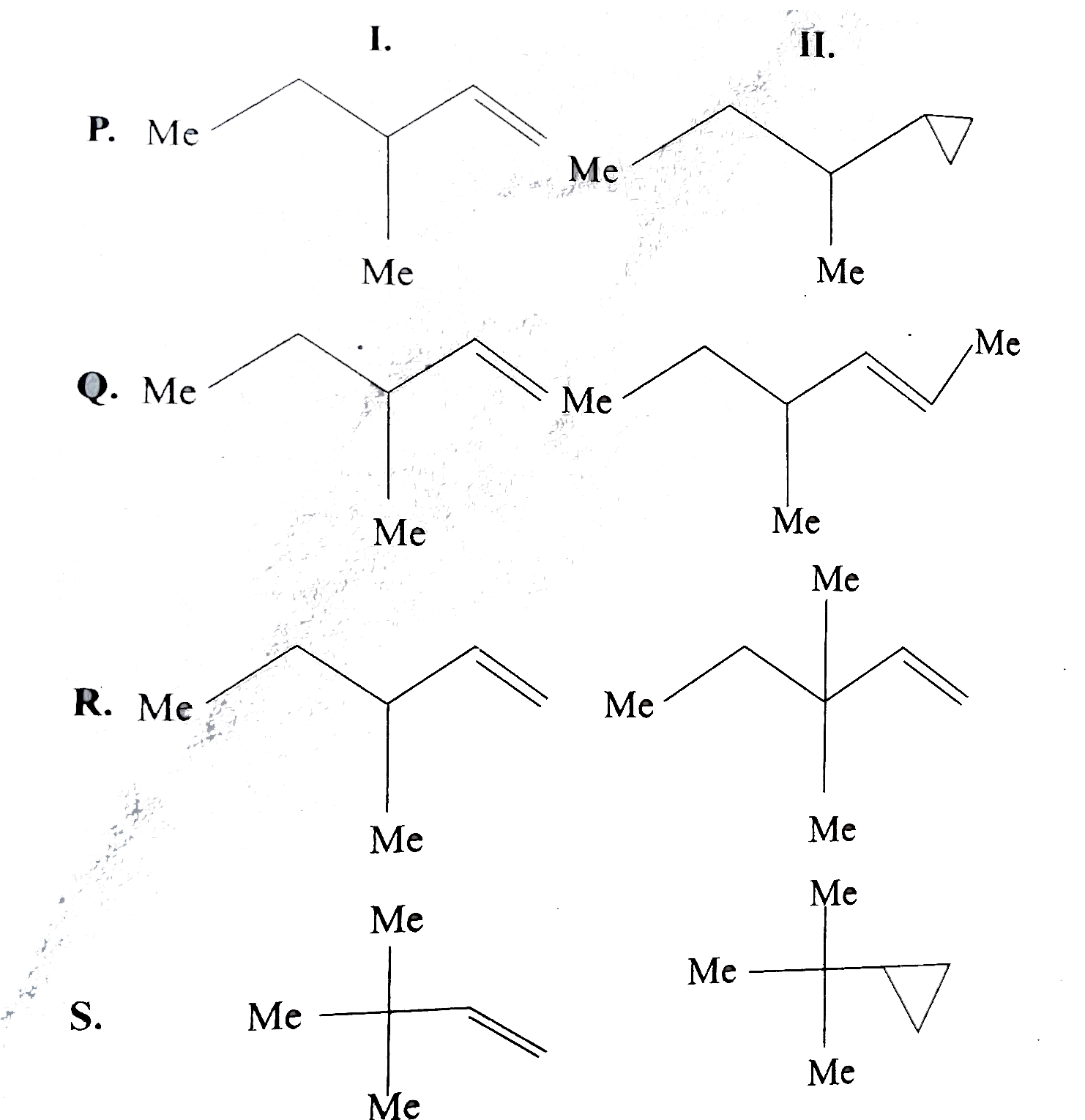Give the structure of an optically active alkene (A) having the lowest molecular mass, which on catalytic hydrogenation gives an optically inactive compound (B).
To solve the question, we need to identify an optically active alkene (A) with the lowest molecular mass that, upon catalytic hydrogenation, yields an optically inactive compound (B).
1. Understanding Optical Activity:
An optically active compound must have a chiral center, meaning it has four different substituents attached to a carbon atom.
2. Choosing the Alkene:
We need to select an alkene with the lowest molecular mass that can be chiral. The simplest structure that meets this criterion is 3-methylpent-1-ene.
3. Drawing the Structure of Alkene (A):
The structure of 3-methylpent-1-ene can be represented as follows:
CH3|CH3−CH−CH=CH2|CH2
In this structure, the carbon at the second position (C-2) is chiral because it has four different groups: a methyl group (CH3), an ethyl group (CH2CH3), a hydrogen atom (H), and a vinyl group (C=CH2).
4. Catalytic Hydrogenation:
When 3-methylpent-1-ene undergoes catalytic hydrogenation (addition of H2 in the presence of a catalyst like platinum), the double bond is reduced to a single bond.
5. Drawing the Structure of Compound (B):
The product of the hydrogenation will be 3-methylpentane, which can be represented as:
CH3|CH3−CH−CH2−CH3|CH2
In this structure, the carbon that was previously chiral (C-2) now has two identical groups (the two methyl groups), making it achiral and thus optically inactive.
6. Final Structures:
- Alkene (A): 3-methylpent-1-ene
- Compound (B): 3-methylpentane
Conclusion:
The structure of the optically active alkene (A) is 3-methylpent-1-ene, and upon catalytic hydrogenation, it yields the optically inactive compound (B), which is 3-methylpentane.
An optically active compound must have a chiral center, meaning it has four different substituents attached to a carbon atom.
We need to select an alkene with the lowest molecular mass that can be chiral. The simplest structure that meets this criterion is 3-methylpent-1-ene.
The structure of 3-methylpent-1-ene can be represented as follows:
CH3|CH3−CH−CH=CH2|CH2
In this structure, the carbon at the second position (C-2) is chiral because it has four different groups: a methyl group (CH3), an ethyl group (CH2CH3), a hydrogen atom (H), and a vinyl group (C=CH2).
When 3-methylpent-1-ene undergoes catalytic hydrogenation (addition of H2 in the presence of a catalyst like platinum), the double bond is reduced to a single bond.
The product of the hydrogenation will be 3-methylpentane, which can be represented as:
CH3|CH3−CH−CH2−CH3|CH2
In this structure, the carbon that was previously chiral (C-2) now has two identical groups (the two methyl groups), making it achiral and thus optically inactive.
- Alkene (A): 3-methylpent-1-ene
- Compound (B): 3-methylpentane
The structure of the optically active alkene (A) is 3-methylpent-1-ene, and upon catalytic hydrogenation, it yields the optically inactive compound (B), which is 3-methylpentane.
Topper's Solved these Questions
- ALKENES AND ALKADIENESBOOK - CENGAGE CHEMISTRY ENGLISHCHAPTER - ALKENES AND ALKADIENESEXERCISE - EXERCISES
29 Videos
- ALKENES AND ALKADIENESBOOK - CENGAGE CHEMISTRY ENGLISHCHAPTER - ALKENES AND ALKADIENESEXERCISE - linked Comprehension Type
38 Videos
- ALKENES AND ALKADIENESBOOK - CENGAGE CHEMISTRY ENGLISHCHAPTER - ALKENES AND ALKADIENESEXERCISE - Single correct Answer
14 Videos
- ALKANES AND CYCLOALKANESBOOK - CENGAGE CHEMISTRY ENGLISHCHAPTER - ALKANES AND CYCLOALKANESEXERCISE - Archives
13 Videos
- ALKYNESBOOK - CENGAGE CHEMISTRY ENGLISHCHAPTER - ALKYNESEXERCISE - Exercises (Archives - Analytical and Desriptive Type)
4 Videos
Similar Questions
Give the structure of an optically active alkyne (A) having the lowest molecular mass, which on hydrogenation with Lindlard's catalyst and Birch reduction gives the same lowest molecular mass optically active alkene.
View SolutionWhich of the following is an optically inactive compound?
View Solution
Knowledge Check
Which of the following alkyne on treatment with H2 (2 mole)/Pt gives an optically inactive compound ?
A3-Methyl-1-pentyneB4-Methyl-1-hexyneC3-Methyl-1-heptyneDNone of the above
Carbene intermediates are produced by the photolysis of diazomethane (CH2N2) or kenene (CH2=C=O). They are also produced by the reaction of CHX3 with base or by Simmons-Smith reaction. There are two types of carbenes, singlet and triplet. They are so called due to their spin state.
An optically active alkene (I) with lowest molecular mass on hydrogenation gives optically inactive alkene, but on insertion of methylene carbene (:CH2) in (I), it gives optically active compound (II). The compounds (I) and (II) are :
 .
.
View SolutionAn optically active hydrocarbon X has molecular formula C6H12. X
on catalytic hydrogenation gives optically inactive C6H14.X
could be
View SolutionAmongst the following compounds, the optically active alkane having lowest molecular mass is:
View SolutionAmongst the following compounds, the optically active alkane having lowest molecular mass is:
View SolutionGive examples of some optically active polymers
View SolutionGive the structures of (A),(B) and (C)(explanation is not required ).
i. (A)(C4H8) that adds on HBr in the presence and in the absence of peroxide to give the same product, C4H9Br.
ii. (B)(C4H8), which when treated with H2O/H2SO4 gives C4H10O that cannot be resolves into optical isomers.
iii. (C)(C6H12, an optically active hydrocarbon which on catalytic hydrogenation gives an optically inactive compound, C6H14)
View SolutionCompound (S) that on hydrogenation product (S) optically inactive compound (s) is/are
View Solution
